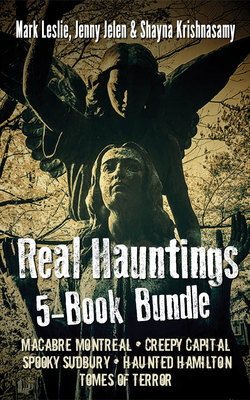Читать книгу Real Hauntings 5-Book Bundle - Mark Leslie - Страница 10
На сайте Литреса книга снята с продажи.
The Tobogganing Ghost of Simon McTavish Mount Royal
ОглавлениеIn the late 1700s, Simon McTavish was the richest man in Montreal. An immigrant of Scottish decent, McTavish prospered as a fur trader, founding the North West Company, which would compete for business with the more well-known Hudson’s Bay Company, and eventually merge with it. Like many rich men, McTavish was known to be arrogant. He was also somewhat of a dandy, and according to Donovan King, who conducts ghost tours of Montreal, he would strut around town in the finest garments, wearing elaborate jewellery and whacking anyone who disrespected him with a gold-tipped cane. Though he was in no way a nobleman, he insisted on being called “The Marquis.”
Perhaps in an effort to literally look down on the inhabitants of Montreal, McTavish purchased a swath of land on Mount Royal, the highest point in the city, right next to a property owned by James McGill. Soon after, in the early 1800s, he began construction of a grand castle for his family, to be built in the Scottish baronial style. As work on the castle neared completion, McTavish liked to stalk around the construction site, striking anyone working too slowly with his infamous cane.
Then fifty-four years old, McTavish would often make the trek up the mountain from his home in Old Montreal on foot. It was on one of these occasions that he was caught in a rainstorm and developed a cold. Being a stubborn man, he would not listen when his doctor instructed him to stay in bed to recover and as a result, his cold developed into pneumonia, then pleurisy, and finally killed him just weeks before the castle was set to be completed.
The snowshoeing club: Bad boys of the 1800s.
There was an elaborate funeral. A mausoleum was built to house his body and a tall stone monument was erected in McTavish’s honour. But work on his beloved castle, so close to being finished, was abandoned. Over the years the structure began to crumble. In an episode of the podcast Listen with the Lights On, King muses about how at one point the disintegrating castle resembled a giant hollow skull from the street below as snow collected in the gaping windows, or “eye sockets.”
Twenty years later, in 1821, McGill University opened its doors, the crumbling castle looming over its buildings from Mount Royal. It didn’t take long for stories to begin to circulate on campus about McTavish, his tomb, and his ghost. These rumours may have been prompted by the school’s rabble-rousing snowshoeing club — apparently the bad boys of the 1800s — who liked to get drunk, strap on their snowshoes, light their torches, and run amuck across the mountain. King likens the sight of these boys and their torches going up the mountain to a fiery snake.
Is that a dead man tobogganing in his coffin?
Apparently, this band of mischievous youths liked to make a pit stop at McTavish’s tomb to try and rouse his spirit by yelling and carrying-on. On one particularly passionate occasion they even went so far as to break into the mausoleum and vandalize the place, tipping over the coffin and spilling McTavish’s remains across the floor.
Simon McTavish’s ghost saw its chance and escaped.
It wasn’t long before there were reports of ghost sightings at the castle. McTavish’s spirit was seen peeking from the doors and windows of the abandoned structure at night. It was even reported that the appar-ition could be found dancing on the castle roof on moonlit nights. But in perhaps the most Canadian description of a ghost sighting ever reported, McTavish’s ghost was spotted tobogganing down the slopes of Mount Royal in his own coffin.
The residents of Montreal became fearful of the mountain after these sightings, and as the castle was a terrible eyesore it was demolished in 1861. To put an end to the desecration of McTavish’s gravesite, the rubble from his castle was used to bury his mausoleum for good. During the demolition a construction worker fell three stories to his death, which some believe was McTavish’s last act of revenge against those trying to bury his legacy as well as, quite literally, himself.
On the Haunted Mountain ghost walk, King posits a logical explanation for the tobogganing ghost. Though it may not be widely known it was almost impossible to obtain legal cadavers, or corpses, for dissection in the classroom until the mid-1800s. Professors had to get creative in order to teach their anatomy lessons, and it’s said that one such McGill professor, nicknamed “The Resurrectionist,” did just that. In the dead of night he would climb up Mount Royal to the Catholic cemetery and dig up a corpse from one of the unmarked paupers’ graves, which wouldn’t be missed, then strap it onto a toboggan and ride down to the medical building.
So we’ve either got a grave-robbing and possibly unhinged professor of medicine, or a dead millionaire out for a joy ride down the slopes of the mountainside he once considered his. Personally, we know which story we’re sticking with. There’s nothing more Canadian than a tobogganing ghost, after all.
